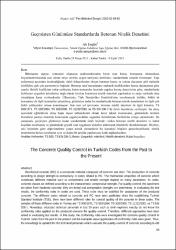Geçmişten Günümüze Standartlarda Betonun Nitelik Denetimi
Citation
Ergün, Ali. "Geçmişten Günümüze Standartlarda Betonun Nitelik Denetimi." AKÜ Fen Bil. Dergisi 10, Sayı.2 (2010) : 69-82.Abstract
Betonarme taşıyıcı sistemleri oluşturan malzemelerinden birisi olan beton, betonarme elemanların boyutlandınlmasında esas alınan proje sınıfına uygun şantiyede üretilmesi standartlarda zorunlu kılınmıştır. Yapı malzemesi açısından incelendiğinde, farklı bileşenlerden oluşan betonun basınç ve çekme dayanımı gibi mekanik özellikleri, pek çok parametreye bağlıdır. Betonun sınıf tanımlaması mekanik özelliklerden basınç dayanımına göre yapılır. Belirli özelliklere sahip sertleşmiş beton numuneler üzerinde yapılan basınç deneylerine göre, standartlarda belirlenen uygunluk kriterlerine bağlı olarak üretilen betonların nitelik denetimi yapılmakta ve proje sınıfında olup olmadığına karar verilmektedir. Ülkemizde, Türk Standartları Enstitüsü’nün kurulmasıyla birlikte, beton ve betonarme ile ilgili standartlar çıkartılmış, günümüze kadar bu standartlarda betonun nitelik denetimleri ile ilgili çok farklı yaklaşımlar ortaya konulmuştur. Son otuz yıl içerisinde, betonun nitelik denetimi ile ilgili kriterler, TS 500/1971, TS 500/1984, TS 500/2000, TS 11222/2001 ve TS EN 206-1’de farklı biçimlerde verilmiştir. Bu süreç içerisinde eğitimlerini almış başta inşaat mühendisleri olmak üzere teknik elemanların, günümüzde üretilen betonların şantiye denetimi konusunda uygulayacakları uygunluk kriterlerinde farklılıklar ortaya çıkmaktadır. Bu çalışmada, geçmişten günümüze kadar standartlarda farklı biçimde verilen betonun nitelik denetimi ve kabul koşulları incelenmiş ve günümüzde geçerli olan uygulama kriterleri anlatılarak örneklerle desteklenmiştir. Böylece, eski kriterlere göre değerlendirme yapan teknik elemanların bu konudaki bilgileri güncelleştirilerek, nitelik denetiminin herkes tarafından aynı ve doğru bir şekilde yapılmasına katkı sağlanılacaktır. Reinforced concrete (RC) is a composite material composed of concrete and steel. The production of concrete according to design strength is compulsory in codes related to RC. The mechanical properties of concrete which constitutes different material such as compressive and tensile strength depend on many parameters. In codes, concrete classes are defined according to the characteristic compressive strength. For quality control, the specimens are taken from hardened concrete, they are tested and compressive strengths are determined. In evaluating the test results, the conformity rules in codes are used. These rules must be satisfied for acceptance of the produced concrete. The different codes related to concrete and RC have been published since the establishing Turkish Standard Institute (TSE), there have been different rules for control quality of the concrete in these codes. The samples of these different codes in Turkey are TS 500/1971, TS 500/1984, TS 500/2000, TS 11222/2001 ve TS EN 206-1. Nowadays, educated technical personals in last 30 years such as civil engineers exactly do not know the conformity rules applied on the produced concrete for quality control. Therefore, different approaches have been arised in evaluating test results. In this study, the conformity rules were investigated for concrete quality control in Turkish codes from the past to the present and the examples about application of conformity rules were given. Thus, the knowledge is updated for the technical personals which evaluate the quality control of concrete according to old conformity rules and the quality control of concrete specimens produced from the same material at same conditions is evaluated accurately by the technical personals.
Source
Fen Bilimleri DergisiVolume
10Issue
2Collections
- Cilt 10 : Sayı 2 [12]



















